The year 2020 finally witnessed the return of the English domestic leagues with many fiery matches being played across the country. Just five days after the New Year’s Day, the FA Cup also made its return as it brought along fascinating ties between clubs from the top four divisions. One of those ties which many fans had their attention last weekend was between Southampton and Huddersfield Town.
Southampton had seen a significant rise from their dreadful run of form in between October and November, which saw them suffered through “that match” against Leicester City. Their strong run in December, though, brought back for the Saints four wins and a draw, including a 1-0 win over Tottenham on New Year’s Day. On the opposite side, an average form in November saw their intention of escaping the relegation battle unaccomplished. With five points separating them from Wigan Athletic, there were still very much left to do for the Cowley brothers. As they travelled to the South Coast, they aimed to come out from the match with a positive result to allow them to create a momentum for them in the Championship.
Still, things went the opposite way for Huddersfield when two homegrown youngsters in Will Smallbone and Jake Vokins scored Southampton’s two goals in the second half to seal the match. This tactical analysis will provide an analysis on Southampton’s 2-0 win over Huddersfield Town in the FA Cup. Meanwhile, using statistics, we will point out the noticeable tactical points in Ralph Hasenhüttl’s tactics and Danny Cowley’s tactics.
Lineups
With the intention of letting most of his key players rested for the next Premier League match, Hasenhüttl made a few changes to the side that secured three points for Southampton against Tottenham. Also, given that they went into this match without having too many names being included on the treatment list, the Austrian manager had a wide range of players to choose from. In his 4-2-2-2 formation, there were two youngsters who featured regularly for the under-23 this season being included in the lineup, which was Will Smallbone and Jake Vokins.
As they made their first professional start for the club, another homegrown duo in Harry Lewis and Callum Slattery looked on since they were being registered among the substitutes alongside Michael Obafemi and Southampton’s top-scorer Danny Ings. Kevin Danso also had his ninth start of the season with him occupying the right-back position and completed the back-four that consisted of the centre-back pairing of Jannik Vestergaard and Maya Yoshida. Up front, Ché Adams continued the search for his first goal for the club as he led the line with the pacey Irish striker Shane Long.
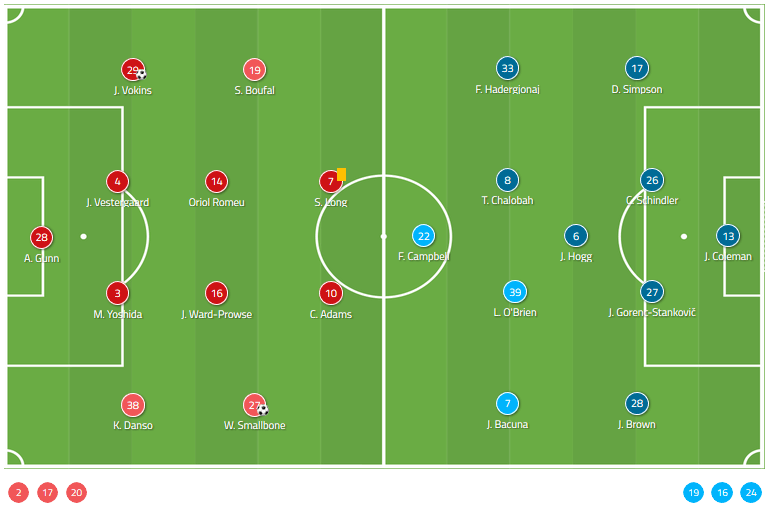
For Huddersfield, they had an overwhelming of absentees from the squad list that travelled to Hampshire last weekend. At the back, veteran centre-back Tommy Elphick missed out through an injury, thus, left Cowley with Christoph Schindler and Jon Gorenc-Stankovič at the heart of the defence for this match. Terence Kongolo hadn’t played for the club since their 5-2 lost against Bristol City, which raised the concern of his match sharpness, and the same can be said with former AS Monaco striker Adama Diakhaby.
Another attacking player that Cowley did not have in his hand when it came to choosing the squad list was Collin Quaner as he continued his recovery from an injury. Elias Kachunga also missed out from this match with him being considered as a doubt for this match. But this did not concern the former Lincoln City manager too much since he had an attacking trio on the bench who was subbed on later in the match in Stevie Mounié, Josh Koroma and Karlan Grant.
Huddersfield’s style of play
Entering this match with a strong team, there was no doubt that Huddersfield wanted to have a positive result for them from this match. Eventually, they did enjoy what is considered as a decent first-half for them with both teams entered the break without any goal separating the two. But in reality, Cowley’s side were on the back foot for most of the time as they tried to counter against and even bypassed the pressure from Southampton.
One of the most noticeable points which demonstrated how struggled they were at St. Mary’s stadium was through their passing map. In possession, Huddersfield were a possession-based side as they aimed to play out from the back, the strategy which made Schindler and Stankovič the focal points in creating attacks from the defensive line. Still, given the fact that they did not have too much time on the ball (as their possession stats – 34% – suggested), it was not possible to create as many connections in between the players in order to progress the ball forward.
In the passing map below, it is easy to see how both centre-backs did not even form a link between them as they only aimed to get the ball towards the advanced options in front of them. There were short links being formed between Huddersfield players, which hindered the chance of sending progressive passes up front for the attackers such as Frazier Campbell or Juninho Bacuna.
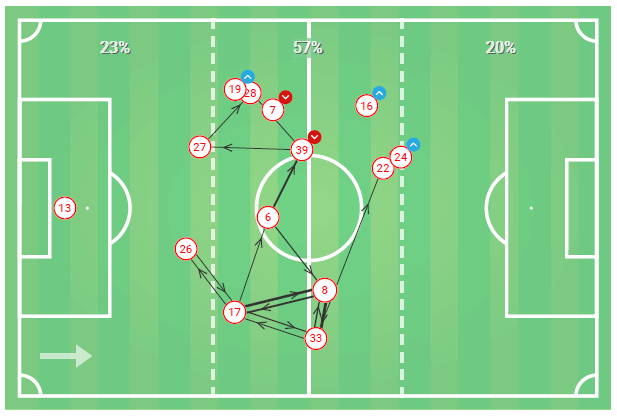
The reason behind that struggle was because of the aggressive press that came from Southampton’s attackers. Whenever the away side controlled the ball inside their half, Adams and Long would immediately move up and mark both centre-backs while attempting to suffocate them. Alongside that, Smallbone and Boufal also drifted wide to follow the full-backs, which, once again, eliminated another possible passing option for the centre-backs.
Finally, their choice of making a pass through the middle area for Jonathan Hogg was also cut off by James Ward-Prowse. The homegrown English midfielder tended to move higher from his position to follow Hogg in the team’s press and created a man-oriented press situation. This left Schindler and Stankovič with no choice beside either send a long ball up front, which did not seem to be a viable option considering Campbell’s lack of physicality, or took the risk and tried to move the ball quickly down both flanks.
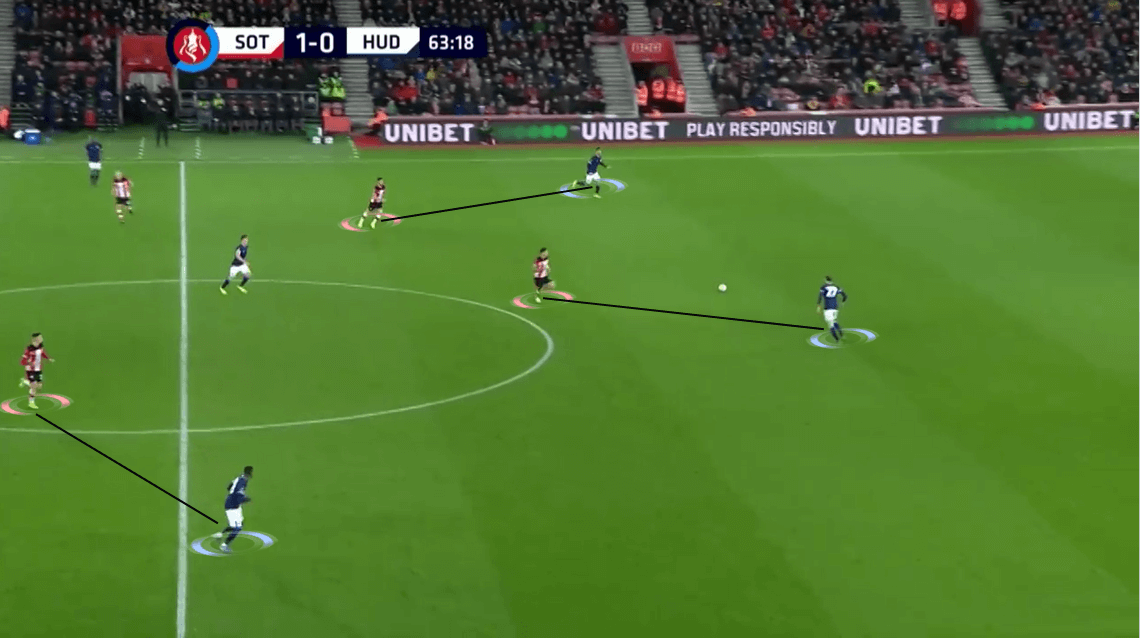
This also turned them into a wing-oriented side, who focused attacked down the right-hand side more often with the help of Danny Simpson and Florent Hadergjonaj. Both of them are natural wing-backs who tended to overlap up the pitch and involved in the team’s attack by creating passing links out wide, especially Hadergjonaj since Simpson started to age and his pace did not allow him to be as active as he used to. Still, Huddersfield had a good day down that right-wing with fifteen chances being created from that flank and brought them a total xG rating of 0.13 xG, a high number compared to the other two attacking directions’ records.
But, as they entered the final third with the ball, there was another problem sparked among the attacking players. Amid that they were able to get the ball into the final third, converting them into significant chances and resulted in goals is another thing. Throughout the whole match, they were only able to create five chances towards Angus Gunn’s goal and only one of them was on target. Not to mention, their highest xG-rated chance was Schindler’s shot in the 56th minute, which eventually went wide similar to the other two.
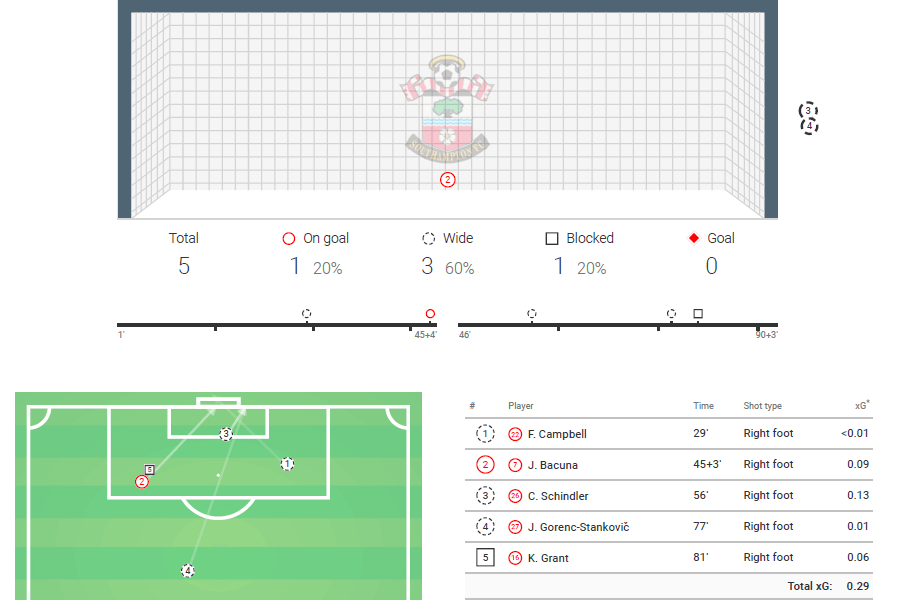
Why did Huddersfield had a bad day in front of goal, you may ask? Southampton’s high press is just one of the reasons as it prevents the away side to enter the other half with the ball. Another reason that can be noticed is the lack of connection between the players and the scoring sharpness of the attackers.
Campbell’s first chance of the day was the perfect example for the lack of scoring sharpness among the players. As the away side was able to recover possession from a high press against Southampton’s build-up, they sent the former Crystal Palace striker into a free state and there was only Yoshida, who he could have beaten with a fake shot, in his way. Instead, he went straight for the shot and put too much power into it and forced the ball to go wide. As good a chance can be like Campbell’s opportunity to open the score, he was a bit hurried in his decision and went for the one that had a lower chance of success.
The situation below demonstrated how the lack of understanding between the players also caused Huddersfield the match. As Trevoh Chalobah was dribbling with the ball, he faced three Southampton defenders in front of him and Vokins retreating back to cover for his teammates. At the same time, Hadergjonaj was positioning himself in free space and could have received the ball to enter the opposition’s half. But the Chelsea loanee opted to take on the opposition’s defenders himself, which eventually forced his team to lose possession and an attack was cut short.
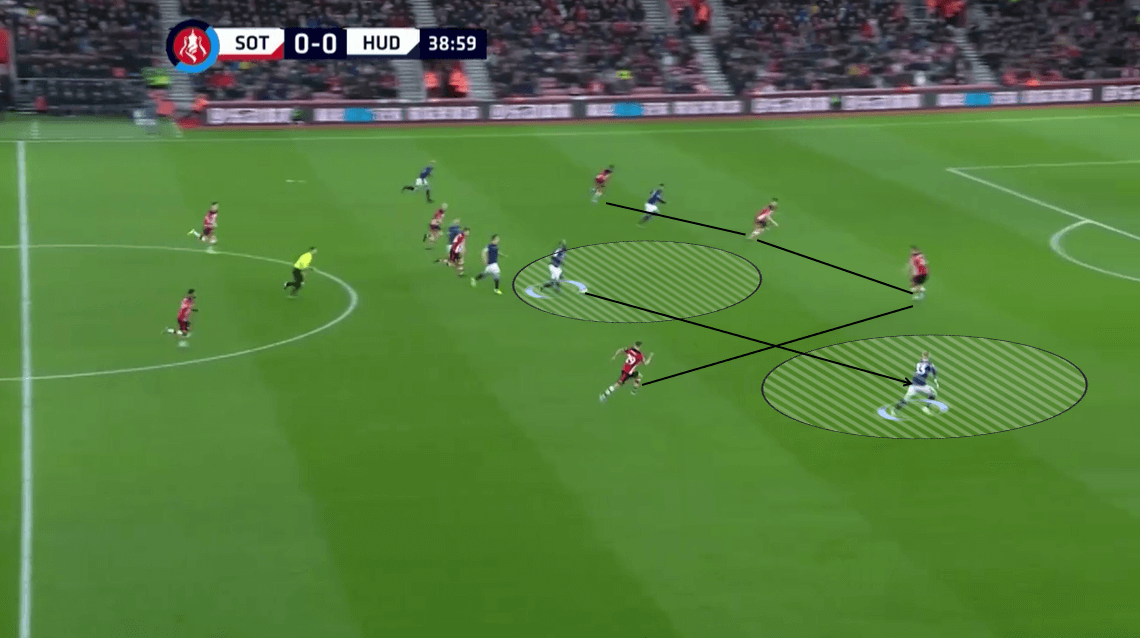
While they did not enjoy much luck at one end of the pitch, things seemed to be decent for them at the other end. When out of possession, Huddersfield players attempted to create a mid-block inside of their half using their 4-5-1 formation. Hogg would move slightly up the pitch to join Chalobah and O’Brien in overloading the central area. Meanwhile, Hadergjonaj and Bacuna out wide would aim to stretch the shape by positioning wider. This allowed the team to control both the central and the wide-area of the pitch in a more effective way, which they did capitalise.
By gaining numerical superiority inside the central half of the pitch, they forced Southampton to distribute wide since there were not many possible passing options for them to beat the midfield line. To counter against Southampton wing attacks, the defensive shape would be shifted towards the ball carrier’s side as the away side attempted to create an overload and win the ball back. This strategy helped Huddersfield to limit the number of chances that Southampton were able to create in the match, which stood at only seven and also allowed them to finish the first half without being conceded. But the defensive contributions could not help a team to finish the match with a positive result, not without the offensive activities and that is what Huddersfield lacked from the match from their attackers.

Southampton’s style of play
Huddersfield’s opponent for this match, Southampton, enjoyed a dominant day both in terms of their attacking scenarios and their defensive abilities. Firstly, it is worth taking a look at their principles when they control possession. With this being a cup match doesn’t mean Hasenhüttl had to treat it in a different way compared to a league match. He still instructed his players to play in a possession-based style that has become familiar with the fans.
In possession, Southampton looked to build their attacks from the back-line as the centre-backs were able to connect with the central midfielders for the majority of the match. The intention of playing Danso as a right-back, though, was included with a plan of creating a three-man build-up to support Vestergaard and Yoshida. As shown in the shot below, the Augsburg loanee tended to turn invert and occupy the right half-space to create a passing block along with the centre-backs and central midfielders.
By having at least five players involved in the build-up phase, it allowed Southampton to gain numerical superiority in case Huddersfield attempted to press high. They were also able to progress the ball out wide since Danso became the focal point when the team attempted to attack down the right-hand side.
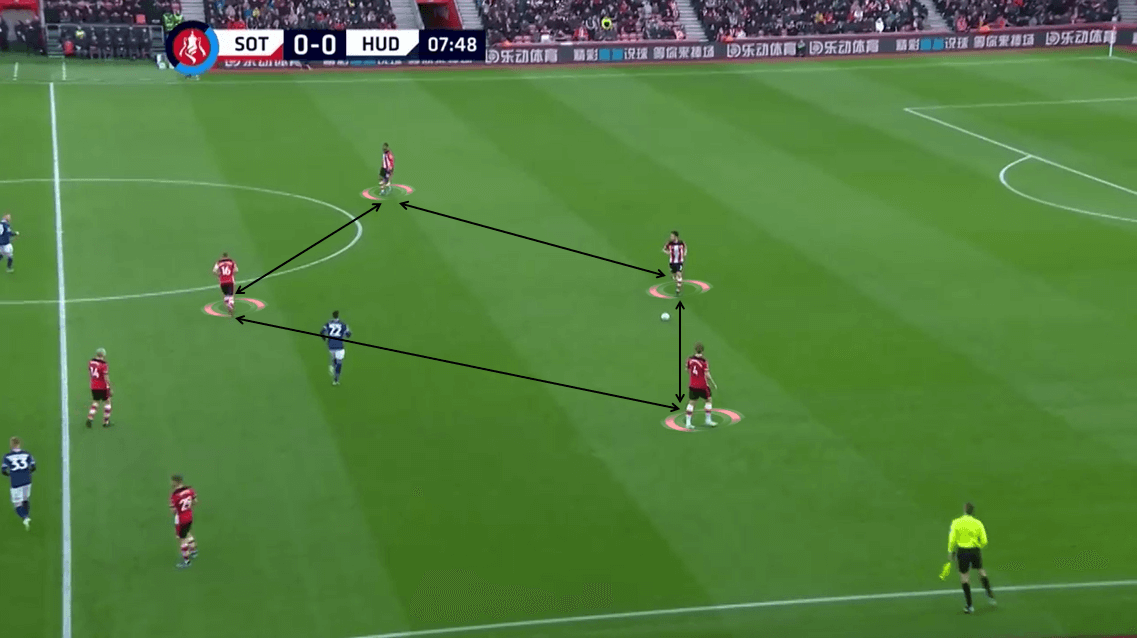
On several occasions, it was viable to see the person who dropped deep was not Danso, but it was Ward-Prowse. In that case, the Austrian defender would stay wide and aim to stretch the opposition’s defensive shape while Ward-Prowse moved into his position to maintain the three-man build-up, similar to the shot below. But it was the positioning of Oriol Romeu that really caught the eye in these situations.
He tended to position himself between Campbell and the midfield line, which he acted as the connector between the passing block with the advanced options. This also helped him in maintaining a sufficient distance with the centre-backs to minimise the passing risk and prevented the scenario of losing the ball either inside their half or in the middle third. With two midfielders who had the passing ability, Southampton were more confident to play out from the back often and picked out the perfect moment to break down Huddersfield’s defensive shape.
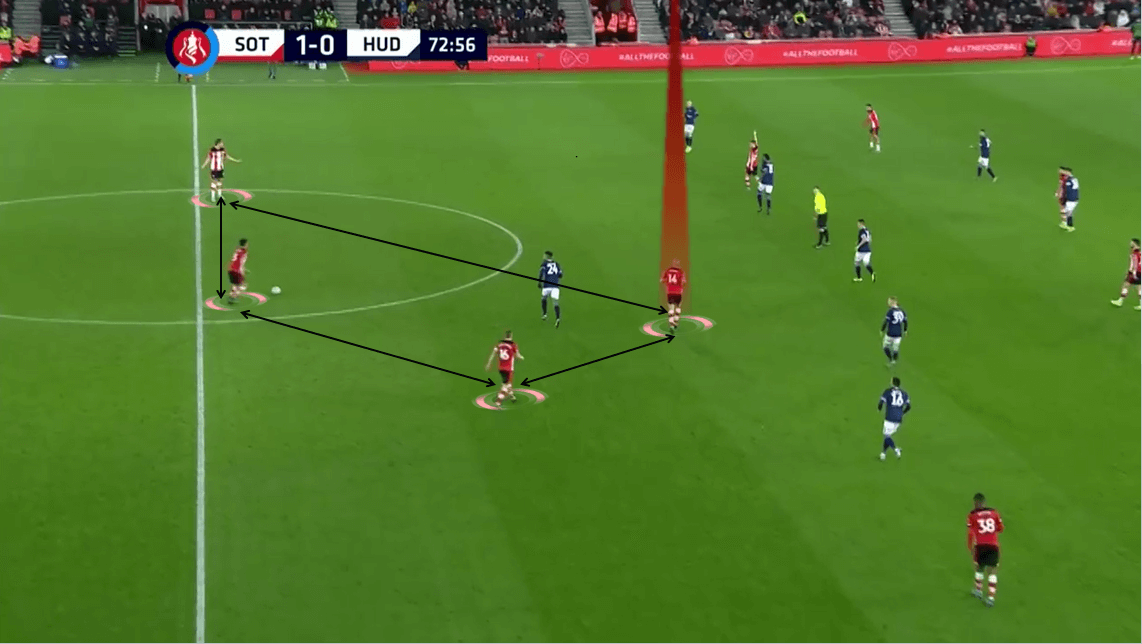
Without being able to progress the ball into the central half of the pitch on several occasions, the method that Southampton centre-backs used to get the ball forward was through long passes. They were encouraged to send the ball long to both wing-backs who already overlapped out wide in order to force Huddersfield’s defensive shape to shift across.
As they completed doing so, space would be created in between the lines as several of the defending players had to leave their positions to mark Southampton’s attackers. This allowed the likes of Boufal or Smallbone to enter that space being created to offer a possible passing option for the centre-back as they attempted to reduce the team’s build-up time.
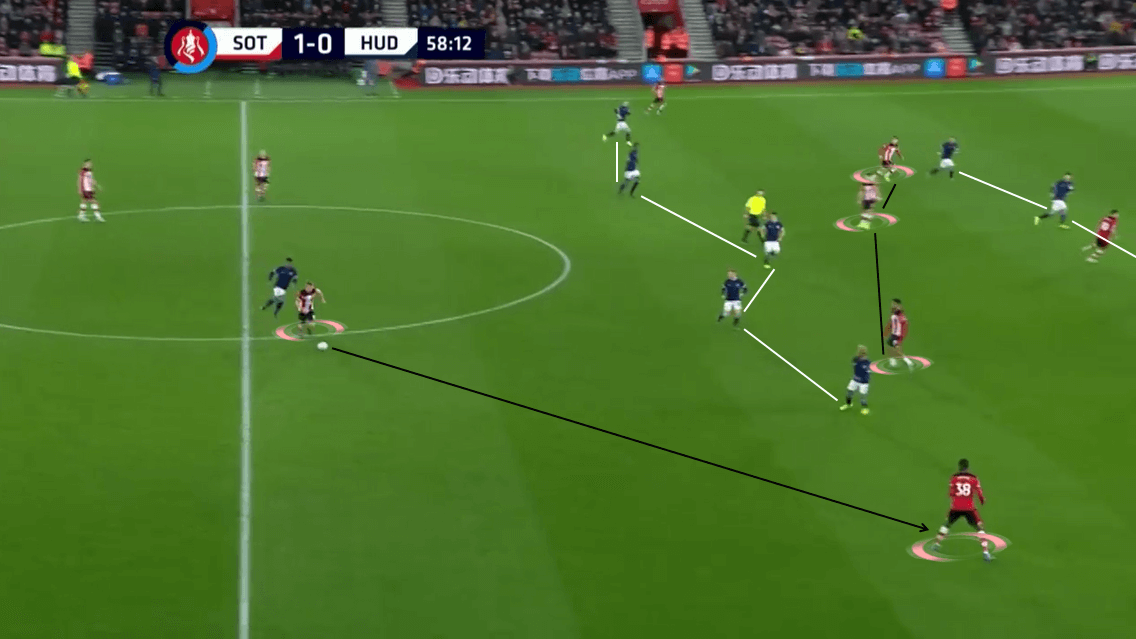
Inside the final third, Southampton showed they have the quality to convert the chances that they created into goals, which was the thing that Huddersfield found themselves lacking. In their total of seven chances created from this match, they were able to get three of them on target and two of them turned into two goals for the two youngsters.
The fact that Southampton were able to capitalise their chances and turned them into the decisive stuff for the match went along with them having higher quality chances through making the most out of the opposition’s weakness, which also made them dangerous on counter-attacks. As mentioned, Huddersfield players tended to create overloads in their half and attempted to recover possession in an aggressive way. This allowed space being created and it was a great opportunity for pacey players like Vokins or Boufal to utilise.
In Vokins’ first professional goal for the club, a similar situation happened when Adams was able to bypass the pressure from (a countless number of) Huddersfield players and even got himself in a free state to pass the ball into Vokins’ run. The English left-back overlapped up the pitch without facing any pressure from the opponent and even at the moment when he took the shot. The ball took a deflection and went into the goal with goalkeeper Joel Coleman was not able to save it.
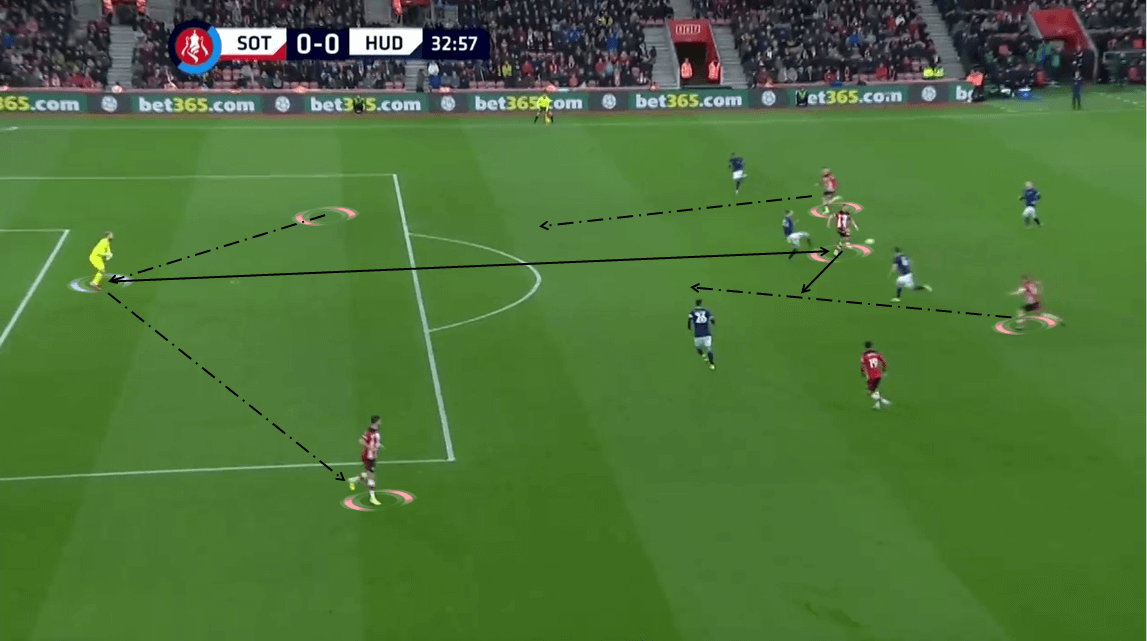
Defensively, Southampton usually executed a high press with the aim of recovering possession high up the pitch. They paid an extensive focus on preventing short passes from the goalkeeper using the pace of Shane Long as the Irish striker attempted to close Coleman down and either won the ball from him or forced him to make a misplaced pass. Eventually, one of those situations did become a chance for Southampton, which is demonstrated below.
It occurred in a similar way that is mentioned earlier with Long closed Coleman down and forced him to make a misplaced pass. The ball found Ward-Prowse as he had two of his teammates ran into the central half ready to receive the pass. It ended up being a good chance for Smallbone to get a goal earlier than that, but his shot was a bit too powerful and went way over the bar.

As the press was bypassed, the players would quickly recover from their attacking positions and formed a 4-4-2 defensive shape inside their half. With two clear defensive lines being created by the defenders and midfielders respectively, it allowed Southampton to monitor Huddersfield’s attacks more efficiently by blocking the possible passing lanes in the central half. At the same time, they would also be able to shift the shape across the pitch to swarm the ball carrier’s flank and recover possession.
This defensive shape required the players to be disciplined about the position that they chose to stand in order not to allow Huddersfield advanced players to capitalise the gaps between the players to enter the final third and receive long passes from their teammates. Another advantage that can be seen from this strategy is the possibility of creating a mid-block to benefit the team’s press, which was something that Hasenhüttl has tried to build over the last two seasons. Even at times, the defensive line of two centre-backs also pushed very high up the pitch and positioned themselves on the halfway line to be ready to clear long passes that came from the opposition’s centre-backs.
On a day that both the defence and attack proved to be working well, the veterans among the teams had provided two New Year gifts to the academy graduates Vokins and Smallbone with their first professional goal for the club. Besides from being a truly amazing moment for these lads, it also helps Southampton to advance into the fourth round of the FA Cup as they aimed to replicate their journey to the semi-final of the competition occurred just two seasons ago.
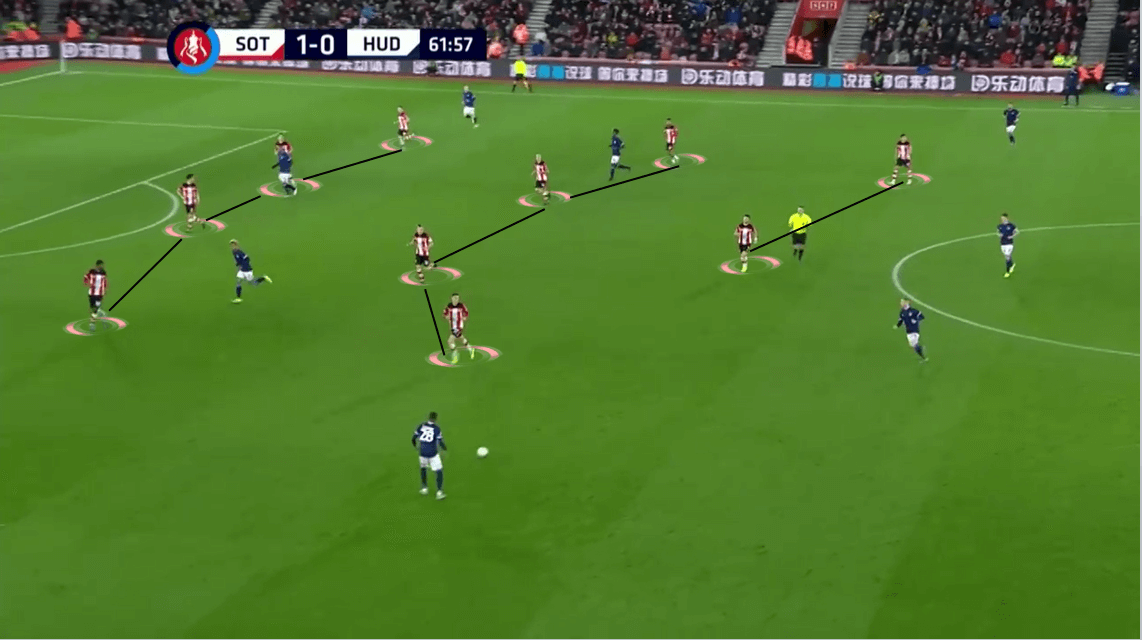
Conclusion
Being considered as the more superior team in this match, it doesn’t come as a surprise to see Southampton continued their encouraging rise after a struggling period. Hasenhüttl has clearly made some changes to the team and the system that he implemented on the team, which will create a momentum for the players to push on for a more positive position on the Premier League league table and maybe a fairytale journey in the FA Cup.
For Huddersfield and Cowley’s players, they still have a lot to do in order to become a version of the Huddersfield that secured the last promotion ticket in David Wagner’s second season with the club. They are in a good position to avoid the drop, which is a good thing, and Cowley needs to build on that in order to secure a place in next season Championship while also thinking of the require additions in this winter transfer window and maybe over the course of the summer window.

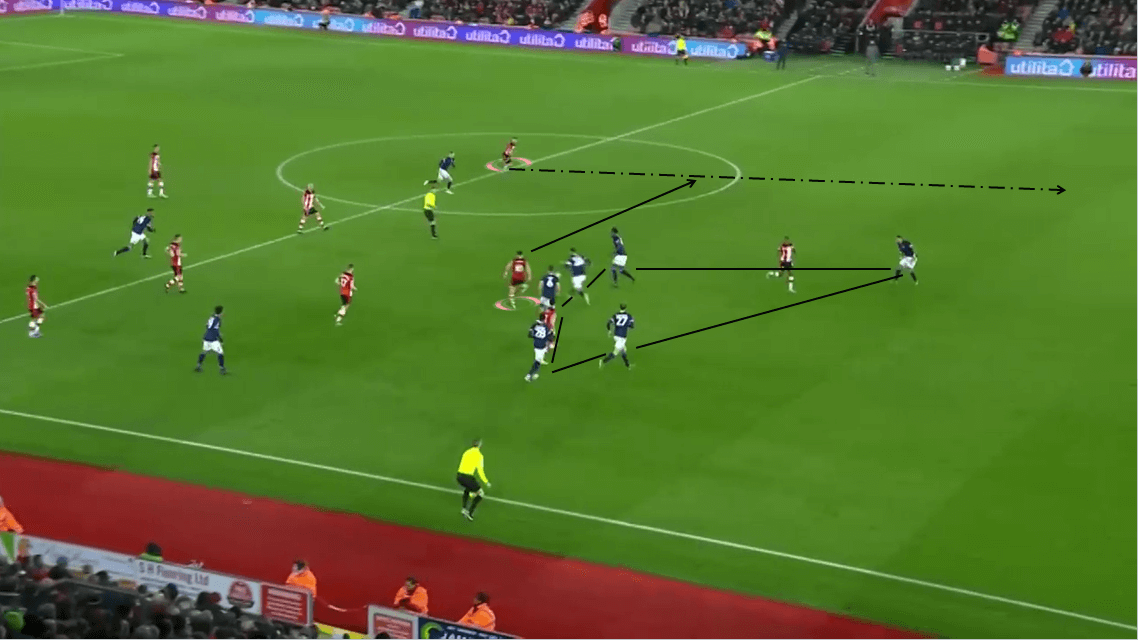



Comments